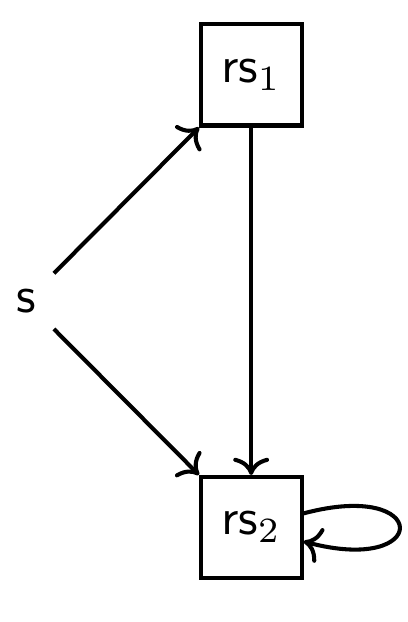Answer Set Programming Encodings for n-ABAFs
This is a collection of ASP-Encodings for n-ABAFs. These things are under active development and might change over time.
Input Format
n-ABAFs are encoded as follows:
Encoding of the Framework
- We have an unary predicate
assumptionswhich indicates that an atom is an assumption of the n-ABAF - We have a binary predicate
headwhere the first argument is the identifier of a rule and the second argument is the head of this rule - We have a binary predicate
bodywhere the first argument is the identifier of a rule and the second argument is one of the body elements of this rule - We have a binary predicate
rule_setwhere the first argument is the identifier of a rule and the second argument is the identifier of the rule set the rule belongs to - We have a binary predicate
contrarywhere the first argument is an assumption and the second argument is its contrary.
- We have an unary predicate
nodeswhich defines the nodes of the derivation graph - We have a binary predicate
start_nodewhere identifies the start node of the graph - We have a binary predicate
edgeswith both arguments being vertices of the graph this gives an directed edge from the first two the second argument. - We have a binary predicate
rule_nodewhere the first argument is a node and the second is the identifier of a rule set. So this maps each node to a rule set.
For example consider the following instance
| Instance | Input File |
|---|---|
Consider a 2-ABAF with
and dependency graph 
|
assumption(a).
assumption(b).
head(r1,p).
body(r1,a).
head(r2,q).
body(r2,p).
head(r3,q).
body(r3,o).
body(r3,p).
rule_set(r1,rs2).
rule_set(r3,rs2).
rule_set(r2,rs1).
contrary(a,q).
% Derivation graph
node(v1).
node(v2).
node(v3).
edge(v1,v3).
edge(v1,v2).
edge(v2,v3).
edge(v3,v3).
start_node(v1).
rule_node(v2,rs1).
rule_node(v3,rs2).
|
Encoding of the derivation graph deduction
Assuming we have a set of assumptions given by the unaryin predicate we compute statements that
can be derived from this set of assumptions by the binary predicated supported_by_node.
The first argument of supported_by_node is a statement that can be derived while the second argument
is a node of the derivation graph. That is, supported_by_node(X,N) states that we can derive X in a way such that our derivation ends in the node N of the derivation graph.
In order to check whether we can derive a statement X we simple check whether supported_by_node(X,N) holds form some node N of the derivation graph.
Encodings of Argumentation Semantics
The following encodings are tested with clingo.
Usage with Clingo.
For the execution of the programs one needs a (disjunctive) ASP solver like Clingo (see Potassco).Enumerate Assumptions Set (and their conclusions).
In order to enumerate all assumption sets of an n-ABAF (given in a file input.af) w.r.t. a semantics (encoded in the file semantics.lp) use the following command:$ clingo input.af semantics.dl filter.lp 0
The filter.lp file filters out the predicates in(.) which denote the arguments contained in the extension.
To just enumerate a fixed number of assumption set, say 6, use the following command$ clingo input.af semantics.dl filter.lp 6
Credulous Reasoning.
Computing all credulously accepted statements:$ clingo input.af semantics.dl filter.lp -e brave
Skeptical Reasoning.
Computing all skeptically accepted statements:$ clingo input.af semantics.dl filter.lp -e cautious
Contact
For further information please contact Giovanni Buraglio or Wolfgang Dvořák.
Disclaimer
The aim of this page is to share tools we developed in our research with the research community. All the software is provided "AS IS", without warranty of any kind.
References
| [2] |
Constrained Derivation in Assumption-Based Argumentation. Giovanni Buraglio, Wolfgang Dvořák, Anna Rapberger, Stefan Woltran AI3@AI*IA 2023. [pdf] |
| [1] |
Declarative Algorithms and Complexity Results for Assumption-Based Argumentation. Tuomo Lehtonen, Johannes Peter Wallner, Matti Järvisalo In J. Artif. Intell. Res., 71: 265 - 318 (2021). [pdf] |
